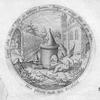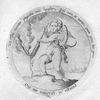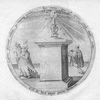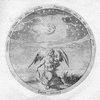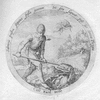Ie reviens de mon gré aux doulx lacqs qui me serrent [11]
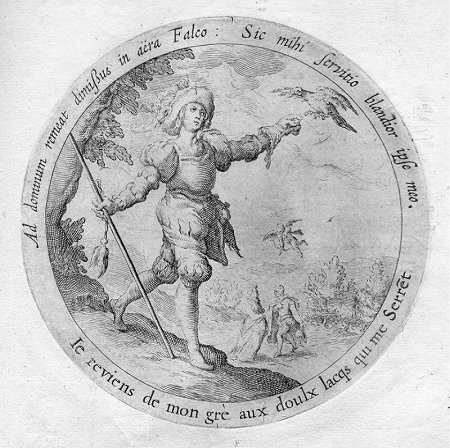
Ten lesten3
ben ick vry/ ick ben eens
uytghetoghen4/
Ick gae daert my ghelieft/ ten lesten noch ontvloghen
De handt die my soo langh ghevanghen heeft gheleyt5/
End my dat schoone licht des Hemels heeft ontseyt.
Ick ben nu vry ’t is waer. wat wil ick doch beginnen/
Hoe lieflick ende soet was my den bandt der minnen?
Ick gae van daer ick quam/ ick vlieghe na de handt/
Om buyten pijn te zijn/ moet ick weer inden bandt.
Ick gae daert my ghelieft/ ten lesten noch ontvloghen
De handt die my soo langh ghevanghen heeft gheleyt5/
End my dat schoone licht des Hemels heeft ontseyt.
Ick ben nu vry ’t is waer. wat wil ick doch beginnen/
Hoe lieflick ende soet was my den bandt der minnen?
Ick gae van daer ick quam/ ick vlieghe na de handt/
Om buyten pijn te zijn/ moet ick weer inden bandt.

Translations
 |
Ik keer vrijwillig terug naar de banden die mijn binden. |
 |
Of my own free will I return to the bonds that bind me. |
 |
Een valk die in het luchtruim wordt losgelaten, keert terug naar zijn
meester. Zo prijs ik mezelf gelukkig met mijn slavernij. |
 |
A falcon that is set free in the air returns to his master. Thus I call myself fortunate that I am a slave. |
Literature
-
Henkel and Schöne, Emblemata
 , col. 784
, col. 784
-
Praz, Seventeenth-Century Imagery
 , p. 95
, p. 95
Sources and parallels
- Same emblem in 1601 edition: Je reviens de mon gré aux doulx lacqs qui me serrent [11] (in: Daniël Heinsius, Quaeris quid sit Amor (c. 1601))
[Compare
![Compare [compare]](/static/images/compare2.gif) ]
]
- Parallel for the entire emblem: Camerarius, Symbolorum & emblematum centuriam
 , bk/embl.
III/29
, bk/embl.
III/29 -
Parallel in the 1616 edition: motto and subscriptio the same, modified pictura (background more detailed, the basket
is lacking, lovers have exchanged positions): Ie reviēns de mōgréaux doulx lacqs qui me serrēt. [35] (in: Daniël Heinsius, Ambacht van Cupido, from: Nederduytsche poemata (1616))
[Compare
![Compare [compare]](/static/images/compare2.gif) ]
]
References, across this site, to this page:
- Je reviens de mon gré aux doulx lacqs qui me serrent [11] (in: Daniël Heinsius, Quaeris quid sit Amor (c. 1601))
- Ie reviens de mongré aux doulx lacqs qui me serrent. [35] (in: Daniël Heinsius, Ambacht van Cupido (1613))
- Ie reviēns de mōgréaux doulx lacqs qui me serrēt. [35] (in: Daniël Heinsius, Ambacht van Cupido, from: Nederduytsche poemata (1616))
Iconclass
A falcon returns to the hand of the hunter; Cupid takes aim at a couple of lovers- predatory birds: falcon (+ flying animal(s))
[25F33(FALCON)(+5262)]

- predatory birds: falcon (+ man and animal)
[25F33(FALCON)(+8)]

- trees
[25G3]

- low hill country
[25H114]

- floating in the air
[31A2763]

- lovers' meeting
[33C22]

- sports, games ~ animals (+ hunting with falcon, hawk; falconry)
[43C1(+4241)]

- Freedom, Liberty; 'Liberté' (Ripa) (+ emblematical representation of concept)
[51E11(+4)]

- Obedience; 'Obedienza' (Ripa) (+ emblematical representation of concept)
[53B5(+4)]

- (personifications and symbolic representations of) Love; 'Amore (secondo Seneca)' (Ripa) (+ emblematical representation of
concept)
[56F2(+4)]

- proverbs, sayings, etc. (with TEXT)
[86(JE REVIENS DE MON GRÉ AUX DOULX LACQS QUI ME SERRENT)]

- Cupid shooting a dart
[92D1521]

![[H O M E : Emblem Project Utrecht]](/static/images/rd-small.gif)




